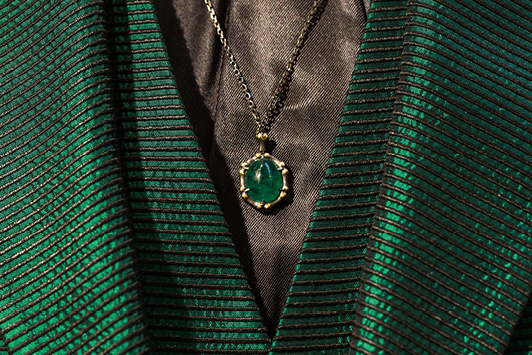
It’s news to gladden the hearts of all who work with gemstones — after 100 years in the doldrums, ornamentation for men is experiencing a resurgence. And today’s males have set the bar high.
“Hip hop, gay marriage and gangster style have all opened the door to diamonds for day,” says James Sherwood, author of
Jewelry for Gentlemen, a sumptuous review of exquisite pieces for men past and present.
What this history of male decoration through the ages shows — apart from how much more elegant a lapel can look with an intricate brooch, or a wrist with a bracelet (à la Elvis Presley and Marlon Brando), or an ear with a diamond stud — is that everything comes full circle.
Male jewelry was big in the sixth century BCE, when leaders wore precious necklaces, headpieces and cuffs to denote power, but it took the Mughals to revive extravagant male ornamentation 2,000 years later. Fresh interest arose in the 1920s, spearheaded by Hollywood royalty as well as the prince of Wales — who became King Edward VIII in 1936 and the duke of Windsor after his abdication. However, a decline in formal dress killed the market for cuff links and cravat pins.
Celebrities have led the 21st-century revival — not just rappers and movie stars, but sports heroes such as soccer players David Beckham and Cristiano Ronaldo, and race-car driver Lewis Hamilton. Also driving the trend is a generation of hip young designers, profiled in this handsome tome. They include Theo Fennell, with his diamond skulls; Stephen Webster, whose fantastical gargoyles and webbed creatures seem inspired by A Game of Thrones; Shaun Leane; Ara Vartanian; Evan Yurman; and Solange Azagury-Partridge.
Naturally, homage is also paid to Cartier, Fabergé, Bulgari, Wartski and other houses that created heavily bejeweled statement pieces for men in their Art Deco heyday.
Probably the most extravagant creation of the past century is the multi-strand necklace Cartier designed for Bhupinder Singh, the maharaja of Patiala, which contained 2,929 diamonds framing a 235-carat central stone. The value of this first reference book on male jewelry is to document rare pieces like this; the necklace has not been seen intact since 1948. Also gorgeous to behold are Fabergé cuff links embedded with ruby and diamond Russian crowns, and a very 21st-century take on wristwear with Stephen Webster’s black-diamond gargoyle links.
Love-token jewelry is here, too. There are pieces for the duke of Windsor that celebrate his love for Wallis Simpson — an interlocking Cartier ring in three shades of gold, inscribed “Darling Wallis,” and a “Hold Tight” inscription on a diamond cuff link. There is also an exquisite diamond-encrusted quiver of arrows by Wartski, which sports removable diamond and ruby missiles designed to be pinned to a paramour’s lapel.
But Sherwood is aiming to inspire future designers rather than merely document the star pieces of the past. “The intention is to show contemporary jewelry in the context of timeless men’s tailoring,” he says. His hope is that modern men will follow their predecessors in once again seeing rings, bracelets, pins and brooches as “wearable works of art.”
Jewelry for Gentlemen is published by Thames & Hudson
Image: The 18-karat blackened yellow-gold and cabochon emerald Villain pendant. Tailoring by Sir. Tom Baker.Article from the Rapaport Magazine - October 2018. To subscribe click here.